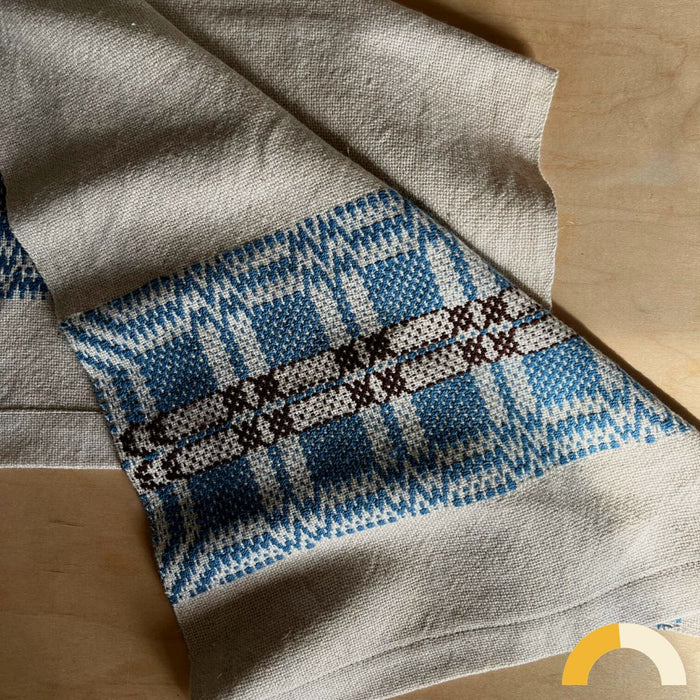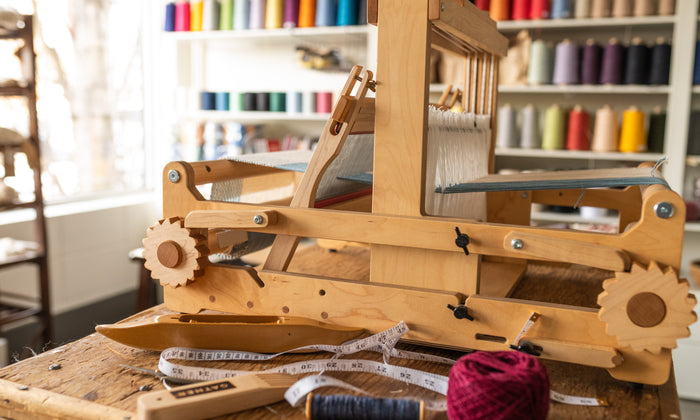Weavers are often wary of linen.
It has a reputation for being unforgiving. We have put together some of the reasons why we love working with linen and some tips and tricks to help you be successful adding linen to your weaving repertoire. With a little care, you can incorporate linen into your projects and enjoy the benefits of this classic fiber.
Top reasons we love working with linen
- Lies flat when pressed making it perfect for table linens
- Gets more beautiful and softer with age
- Has a beautiful sheen
- Linen is a natural fiber that withstands wear and tear
- Conducts heat away from the body making for comfortable clothing and bedding
- Linen is great for summer clothing, rug warps, wall hangings, table linens and more!
- You can feel good about weaving with linen. It is made from the fiber of the flax plant. Flax is important in crop rotation and reduces pests and diseases. Linen is a great choice for environmentally conscious weavers.
Inherent characteristics of linen
- Linen is more stiff and has less elasticity than cotton.
- Linen is absorbent and has a high sheen
- Linen has a smooth surface. This allows it to repel dirt and bacteria. Stains are removed easily.
- Linen dries quickly, making it great for towels.
- Linen generally shrinks very little, usually less than 10%
There are many types of linen, here are a few terms to help you choose.
Line Linen- considered the best quality, line linen is considered the highest quality linen. It is smooth, shiny, and spun from the longer most lustrous fibres. Our Normandy Linen is line linen.
Tow Linen- Spun from short fibers. The end product is hairier and has less sheen than line linen. Tow linen is more absorbent and has higher twist to keep the fibers together.
Wetspun- linen spun using water, leaving less hairy fibers sticking out and leaving more sheen. Recommended for warp yarns. Our Normandy Linen is wetspun.
Dryspun- linen spun without the use of water. Coarser yarn. Linen is stronger when wet.
Tips for weaving with linen
- Use a cotton or cottolin warp and use 100% linen only in the weft. Linen is usually more expensive than cotton so this is economical as well as easier to work with.
- Increase moisture: Linen behaves much better damp. It is easier to beat in and less wiry. Using a humidifier in the room can help, but I normally just keep a spray bottle close to my loom to wet the portion of the warp I am about to weave in front of the beater. I am careful not to get my loom too wet! I also often prepare my bobbins by keeping them in an air tight container that has a small amount of water in the bottom. This keeps the linen on the bobbins moist and ready to weave.
- Wind your bobbin under even tension. This will help the yarn come off the shuttle easily and decrease the need to adjust your selvedges.
- Sometimes when weaving with linen, the yarn seems to almost “jump” off the bobbin! Hold your shuttle in a way that allows you to control the speed that the linen leaves the shuttle. I do this by holding my open bottom shuttle with my palm facing up, so I can control the bobbin speed by touching the bobbin from underneath.
- When weaving with linen it is extra important to keep good tension. Remember to advance your warp regularly so you are weaving in your loom’s “sweet spot”.
- Beaming your warp back to front helps to keep control of linen warps.
- As soon as you tie on your warp to the apron rod, spritz your warp with a little water and weave a header. This will secure the good tension and decrease the chance that your ties will slip and change your tension before you get a chance to start weaving.
Wet Finishing Linen
- Linen will look and feel rough like burlap when it is first taken off the loom. It needs to be wet finished and either hard pressed or mangled. When finishing a linen project, some say to avoid using the dryer to avoid the linen losing it’s sheen. Personally, I will use the dryer for towels because I like the softness that the dryer adds to the linen over time. I will avoid the dryer for table runners or decorative pieces.
- A hard press while damp works well for cottolin towels.
- What is mangling? Mangling uses weight and sometimes moisture or heat to flatten the yarn and create a smooth polished surface on the fabric. I lay out my damp wet finished linen on my granite countertop and take a ceramic rolling pin to it. Don’t hesitate to put some muscle into this part! I also happen to have access to a printing press. If I get the chance I will send my woven linens through the press for a really intense mangling!
Weaving with linen is totally worth the effort.
We look forward to seeing your linen projects!









